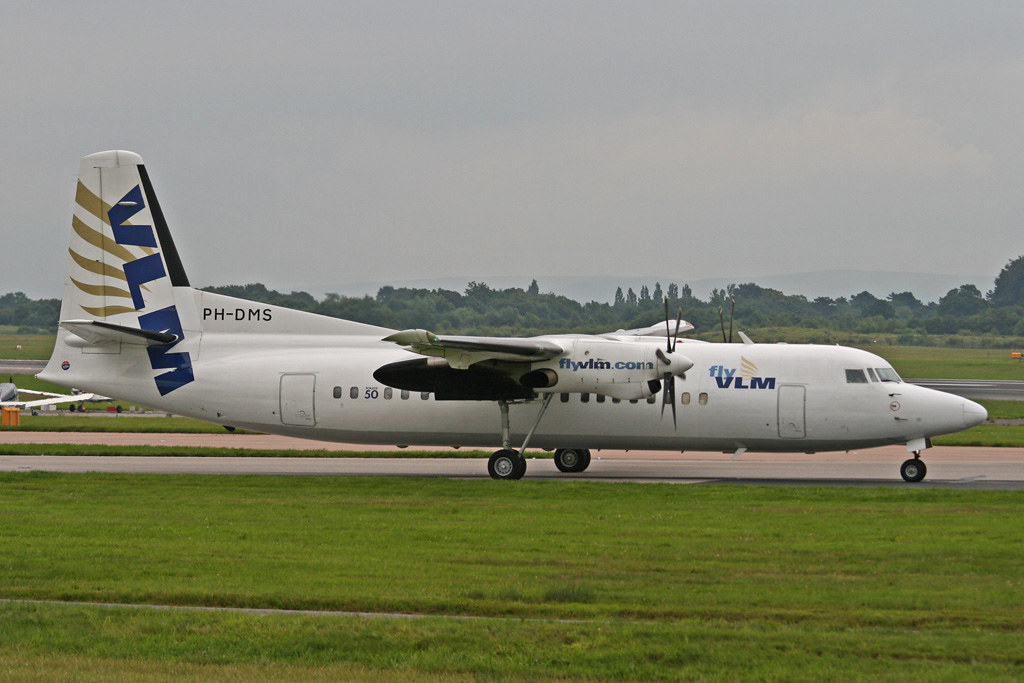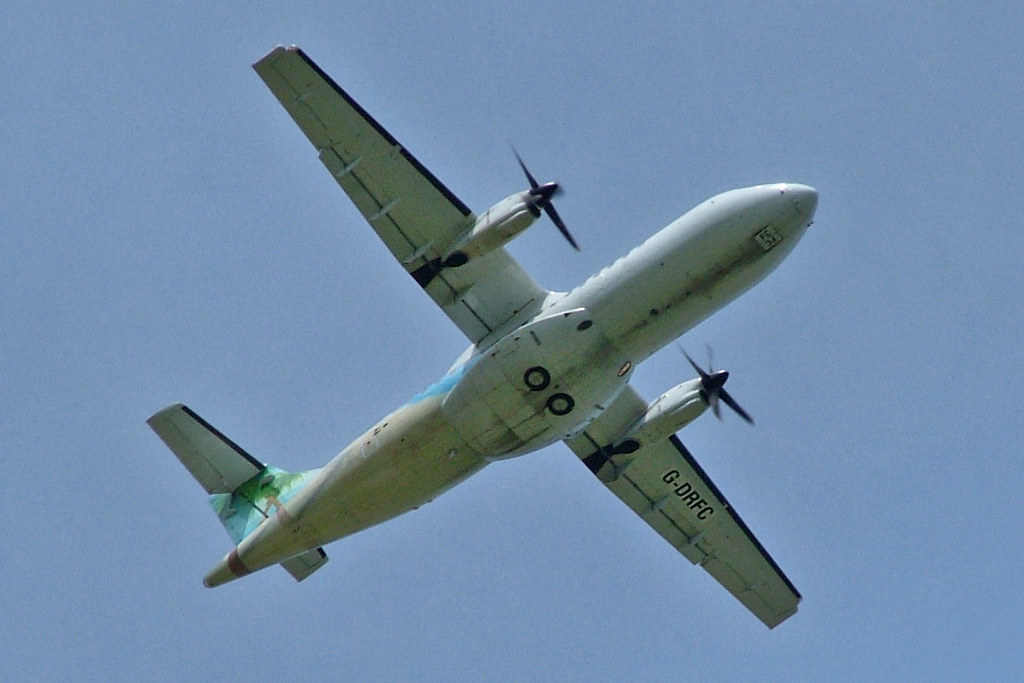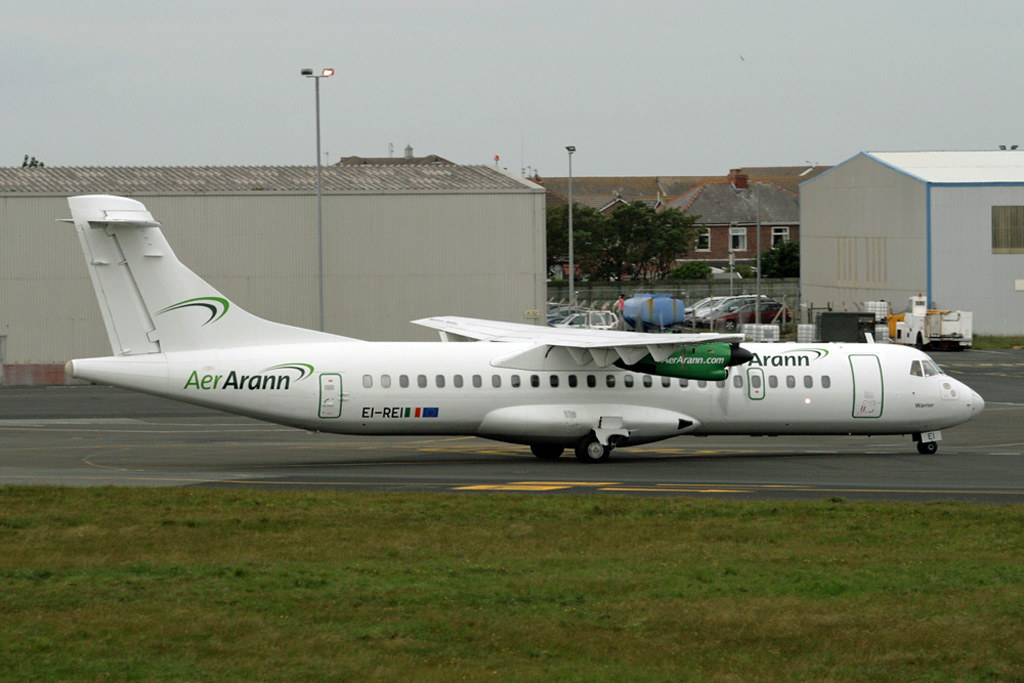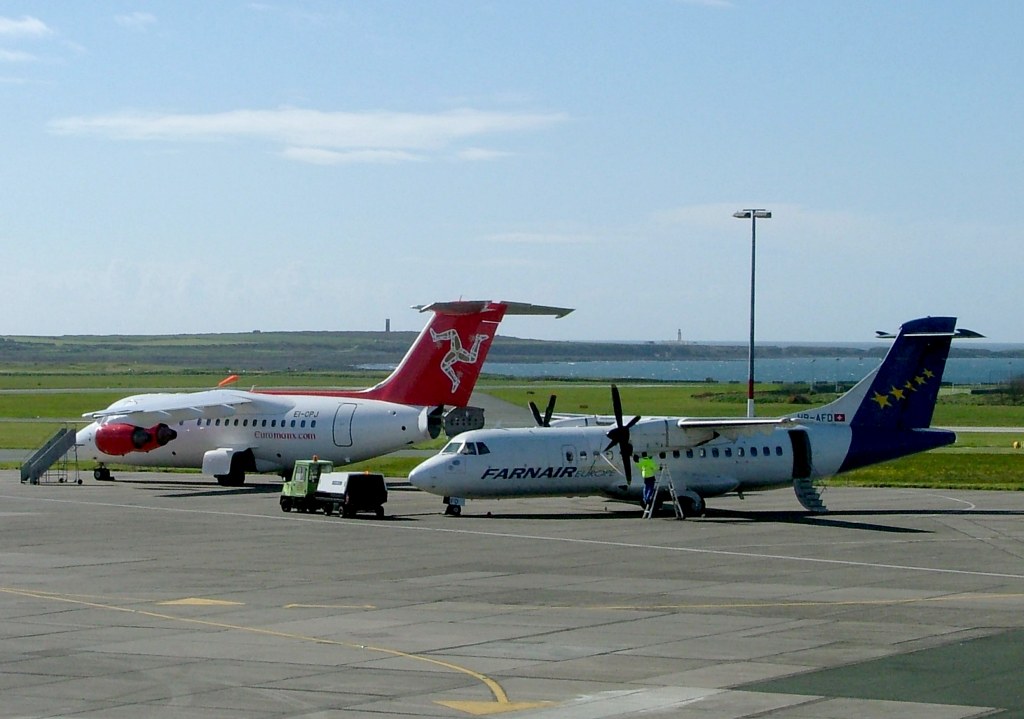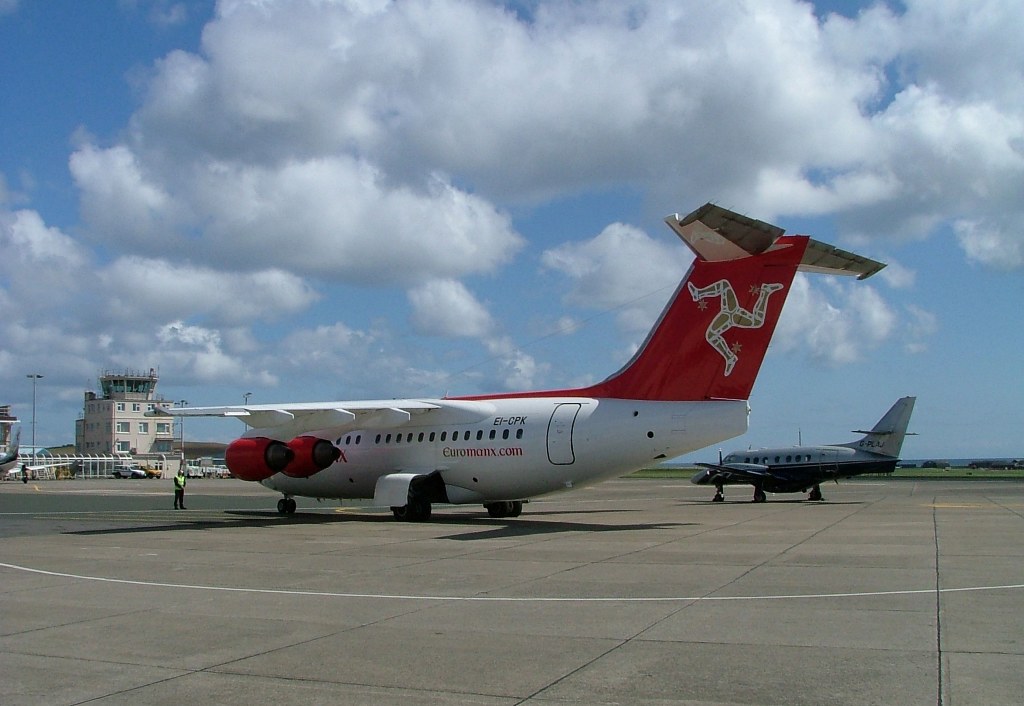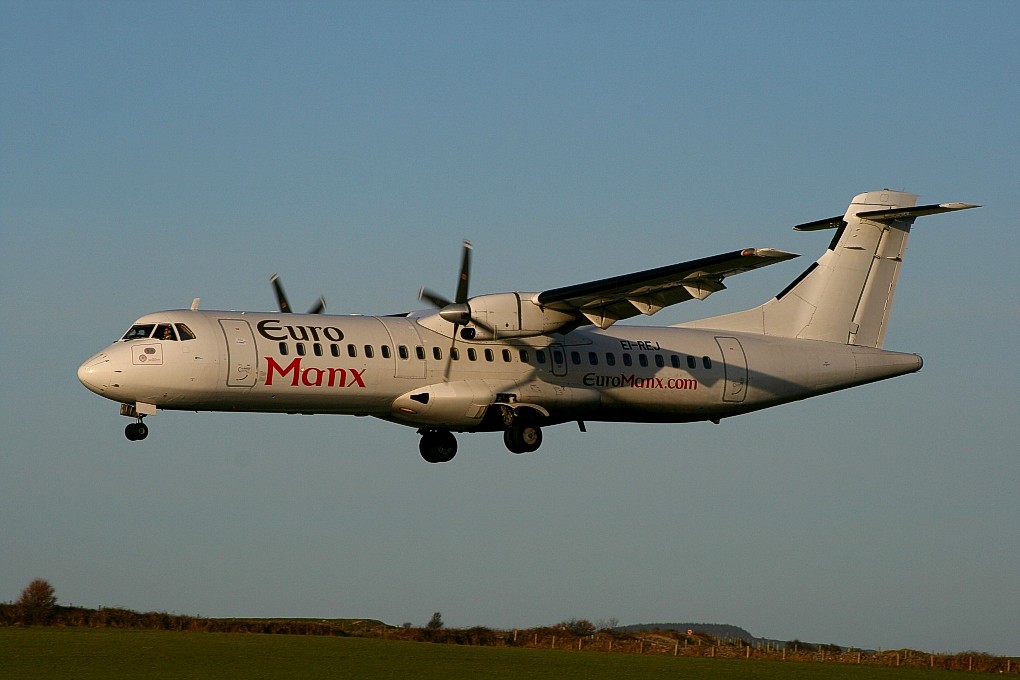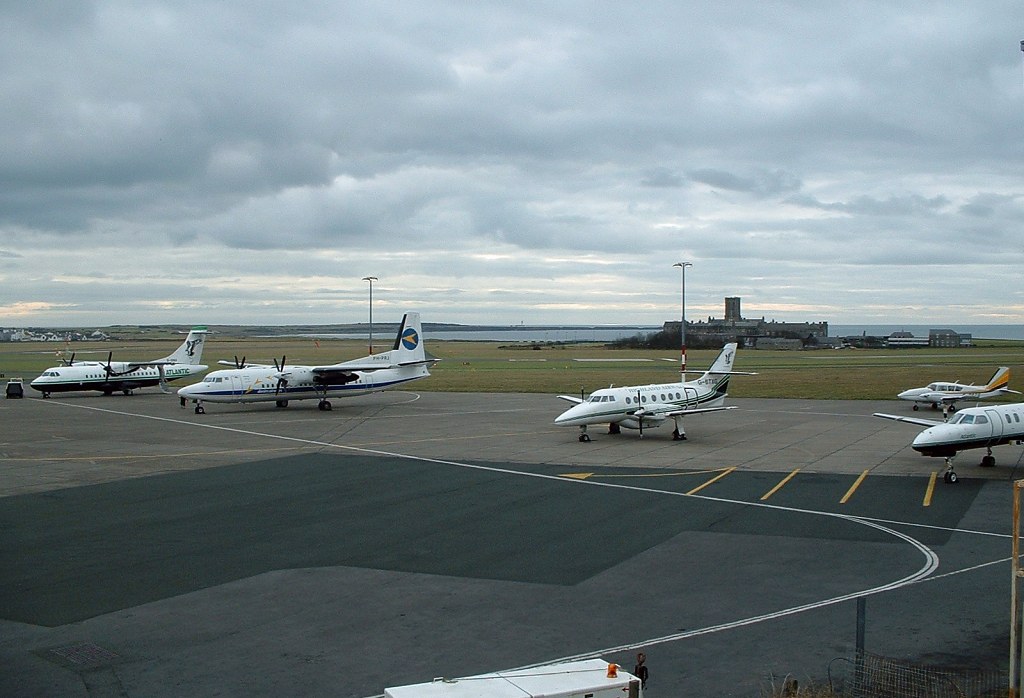So, who remembers EUROMANX? (2002-2008)
Nov 23, 2019 22:04:59 GMT 1
andyh, ian531, and 4 more like this
Post by viscount on Nov 23, 2019 22:04:59 GMT 1
SO, WHO REMEMBERS EUROMANX?
Brian JonesThis article was written for FoLA and appeared in their ‘09/27’ issue for Summer 2019. Their editor was provided with a great choice of images, but just used two (although one was the cover photo), nor were the tables included either, so NWAN readers benefit from the flexibility offered by the forum format.
INTRODUCTION
This is a somewhat ‘Liverpool centric’, rather than the full story of the impact made by this Isle of Man based airline which briefly built quite a network of routes across Europe, before the company retrenched and ultimately failed. This is mainly an account of EuroManx’s operation on the Isle of Man to Liverpool route, although where relevant (and known), the wider picture is mentioned.
LAUNCH AND THE FIRST TWO YEARS OF OPERATIONS
In short, EuroManx were formed in August 2002 and ceased operation in May 2008. This was an unsettled period for operators from and to the Isle of Man, with routes changing hands, periods of intense competition and a background of falling passenger numbers as traditional domestic destinations struggled to adapt to 21st Century tourism and business demands. The previous 20 years had been relatively stable in terms of operators serving the Isle of Man, with Manx Airlines dominating the scene and achieving great customer loyalty. It is not the purpose here to look at the demise of Manx Airlines, other than to state that at the start of September 2002 British Airways absorbed Manx Airlines, and BA CitiExpress took over operation of Manx Airline’s core Isle of Man services. Although operations between Liverpool and the Island initially continued at 5 return flights per day utilising the same BAe.ATP aircraft, fares increased and CitiExpress earned a reputation for the running down of their IoM route with contracting schedules and seemingly random cancelling of flights.
Some on the Island thought the time was right to launch a new airline with a local ability to meet the needs of residents in much the same way as Manx Airlines set out to do in late 1982. Allan Keen MD of Manx based air taxi and air ambulance operator, Woodgate Aviation at Ronaldsway put together plans to launch EuroManx, combining with Rossair Europe a Dutch operator offering Beech 1900D and ATR-42 aircraft for wet-lease. The aircraft were operated under Rossair’s AOC (Air Operator Certificate), EuroManx being in the early years a licensed ticketing agent rather than an airline – although this distinction would not be readily apparent to passengers, and indeed a public pretence was made that EuroManx was a full airline.
Initial operations connected the Isle of Man with Glasgow and Edinburgh using a sole 19 seat Beech 1900D, PH-RAR, still in the titles of its former South African operator. Flights began on 19th August 2002, with East Midlands added to the network in early October. In mid-November EuroManx announced that they would join CitiExpress on the Liverpool route from 2nd December 2002, flights to be operated by a second Beech 1900D with a frequency of 5 rotations on weekdays, 4 on Saturday and 3 on Sunday. Flight numbers were in the block ROS 407-436, with four published return fares: £79, £99, £129 and fully flexible £149. Although EuroManx had IATA code 3W (later 6N) and ICAO code EMX allocated and used for passenger ticketing, this is confusing, as flights were operated under Rossair’s AOC so ‘airside’ their ROS code and R/T ‘Catcher’ call-sign were used. The initial aircraft PH-RAR was aided by either PH-RAH or PH-RAE, although by early 2003 it was PH-RAR and PH-RAT that became the regulars with both acquiring EuroManx titles, while PH-RAE or PH-RAH were used as fleet ‘back-up’ when one of the regular pair where out of service.
Despite using the small 19-seater Beech 1900D to compete with CitiExpress’s larger BAe.ATP aircraft, passengers accepted the aircraft with the more individual attention it provided and the customer base quickly grew. Plans to link their destination network were assessed during April with Liverpool to Glasgow and Edinburgh services proposed, but nothing eventually came of these plans. For a week leading upto Easter weekend in 2003 an ATR-42 was trialled 11th-18th April using Rossair’s PH-RAQ still in City Connect titles, promoted by special fares. From 1st May frequency on IoM-Liverpool increased to six rotations Monday to Friday and a reduced frequency at weekends, while CitiExpress offered 5 per day with BAe.ATPs, 6 on Saturday and 5 on Sunday. By July EuroManx appear to have been usually operating 3 Beechcraft PH-RAH, PH-RAR and PH-RAT. For two weeks over the late Summer Bank Holiday (24th August to 6th September) the ATR-42 PH-RAQ was back, now devoid of titles. For much of September the fleet was down to PH-RAR and PH-RAT so at times Atlantic Airways Metro G-BUKA or Highland Express Jetstream 31 G-UIST would deputise. During October the fleet returned to 3 Beechcraft 1900Ds. In November EuroManx announced the LPL-IoM fares would now start at £38 return incl taxes; while BA CitiExpress faced with falling demand and a service that did not really fit-in with their main network would pull off the route in April 2004. A great boost to EuroManx who did not wait until then to develop the route, as from 30th November all white ATR-42 PH-RAK replaced the Beech 1900Ds on most Liverpool flights. On 11th December after two days absence it reappeared with EuroManx branding and logos and was joined on 19th December by PH-RAQ initially without titles but gaining them after a few months anonymity.
During February 2004, as CitiExpress ran-down their flight frequency, so EuroManx increased their’s to 6 daily Monday to Friday and 5 on both Saturday and Sundays. Most flights were operated by the ATR-42s, although Beech 1900Ds PH-RAR and PH-RAT (and a couple of flights in February by a ‘new’ one PH-ACY) were used on some flights. Small operators always have problems covering both scheduled maintenance ‘down-time’ and for unexpected AoG (aircraft on ground) ‘tech’ issues. Cover aircraft noted at Liverpool, many for just one rotation and only rarely for more than a day’s flight programme included ATR-42s: Farnair’s OY-JRY (Feb); Atlantic’s G-IONA (Apr, Sept, Oct), G-DRFC (Oct), Titan’s G-BUPS (May, Jun) & G-ZAPJ (Aug), Air Wales’s G-SSEA (Jun), G-CDFF (Jun); Jetstream 41 Eastern’s G-MAJG (Mar); BAe.146s G-DEBE (Apr), Titan’s G-ZAPK (Jun), G-ZAPN (Apr); Fokker 50 VLM’s OO-VLS; Metro III Atlantic Avn’s G-BUKA (Jun). To be fair a few of these were to provide extra rotations during Manx TT week. In July PH-RAQ was away for heavy maintenance, so former Air Wales ATR-42 aircraft G-CDFF, G-SSEA and G-KNNY covered for several weeks.
COMPETITION ARRIVES
Having just ‘seen off’ the established carrier on the Liverpool to Isle of Man route at the end of March 2004, EuroManx was soon to find itself the subject of competition. Emerald Airways of Liverpool announced their attention to return to Isle of Man scheduled services, now using BAe.ATP aircraft. Previously Emerald had operated HS.748 aircraft in competition with Manx Airlines 1996-1999. The new Emerald service commenced on 10th May 2004 with a frequency of 5 return flights Mon-Fri, 6 on Sat and 5 on Sun; adding to the existing 6 return ATR-42 flights Mon-Fri, 5 on Sat and 5 on Sundays operated by EuroManx.
EUROMANX GAINS NEW OWNERS
During July plans were released to standardise the fleet on 2 x ATR-42 and a single ATR-72, with the Edinburgh service to be dropped as it was proving not to be viable. A steady, but fair, expansion in just two short years from a single Beech 1900D. However before these plans became action, in September 2004 the founding owners announced that EuroManx had been sold to consortium of UK based aviation professionals and investors headed by Corporate Jet Services. This rescue came just in time to save EuroManx who were facing financial issues. During October the Isle of Man to Liverpool route continued to be operated by the two Rossair ATR-42s with occasional use of the two Beech 1900Ds, although these had both left the fleet by the end of the month. During November the new management made their plans known. The Rossair wet-lease and AoC agreement would terminate at the end of November 2005. A new wet-lease agreement with Denim Air would bring in two Fokker 50 aircraft to replace the ATR-42s. The airline would add a pair of Avro RJ-70 jets, which would be operated in an agreement with Flybe on IoM-London City and IoM-Southampton routes from 10th January 2005.
It is important to note that while, with new owners EuroManx had now become a ‘proper’ licensed airline, the airline company was “EuroManx GmbH”, registered in Austria. This fact was largely disguised from the travelling public, who were encouraged to believe that this airline was ‘Manx’.
So it was that Rossair’s ATR-42 PH-RAQ was last used on Liverpool services on 29th November 2004 and PH-RAK last called the following day 30th November. While Denim Air’s Fokker 50 PH-PRJ was delivered via Liverpool on 30th from Eindhoven and onto the Isle of Man the next morning (1st Dec), with PH-KXM first services to Liverpool on 1st December, PH-PRJ on 2nd and PH-DMS first appearing on 27th December. All three wore Denim Air titles throughout their period of service with EuroManx, and operated under the Denim Air ICAO flight prefix ‘DNM’, rather than EMX.
In January 2005 EuroManx took over the former Flybe IoM – London City link, but with delivery of their RJ-70 aircraft delayed, they used an ATR-42 leased from Atlantic Aviation. Despite a lack of aircraft, further expansion announced in January was that they would commence an IoM to Manchester service in direct competition with BA CitiExpress, twice daily from 28th March, along with a seasonal weekend IoM to Bristol service and in April would commence Southampton to Vienna using Dornier 328 aircraft (although this service never started). During the Spring it became clear that Galway had replaced Southampton as a route ‘hub’ and their future fleet plans would revolve around DHC Dash 8Q, Dornier 328 and RJ-70 aircraft. However their anticipated ‘in-service by’ dates would prove woefully optimistic and a wide variety of aircraft were used for short-term cover throughout the Spring and into the Summer. While waiting for their own new aircraft, EuroManx leased-in mainly BAe.146 and ATR-42 aircraft. Meanwhile, on the Liverpool services the Denim Fokker 50s were a constant with just one rotation in January using Metro III G-BUKA and one in Feb using ATR-42 G-IONA as cover. In March Jetstream 31 G-CCPW, EMB-120 Brasilia F-GFSO and Metro III G-BUKA found their way into Liverpool as cover or extra flights. At the end of March the IoM-LPL frequency went up by 3 flights per week for the summer season. In April with a shortage of available Denim Air Fokker 50s, there were a couple of interesting substitutions. The first of EuroManx’s delayed own RJ-70s, EI-CPJ was delivered to the IoM 17th April and first appeared on a Liverpool flight on 25th. Before that during April they used Atlantic’s G-IONA, Titan’s G-ZAPN and G-ZAPO, Farnair’s HB-AFD all ATR-42s alongside two Denim Fokkers, PH-KXM and a ‘new’ one PH-JXJ. The shock for enthusiasts was provided on 18th April when MD-88 TF-JXB operated the DNM 405/406 rotation, a large aeroplane for the (then) fairly limited Ronaldsway runways, even if lightly loaded! Delivery of the second RJ-70 EI-CPK should have helped, it was delivered on 27th April 2005 and it was first noted on a Liverpool schedule on 19th May. However earlier in May EuroManx, after only 5 months, had dropped using Denim Air from 12th, the last Denim Air Fokker 50 on a Liverpool schedule being PH-JXJ evening of 11th. With delivery of their Dash 8s and Do.328s still delayed, a wide variety of aircraft appeared over the following 4 weeks on their flights into Liverpool. In May these involved 9 different aircraft of 5 types: Fokker 50 (OO-VLV), ATR-42, BAe.146, Do.328 (G-BZOG) and an ATP (G-JEMA). The frequency of service in May 2005 provided on weekdays 5 return flights by Emerald and 6 by EuroManx, with 6 Emerald rotations on a Saturday to EuroManx’s 5 and 5 return flights each on Sunday.
The, presumably quite costly, fleet confusion continued into June with a wide variety of aircraft on short-term ‘cover’ during the first 12 days. While EuroManx’s own RJ-70s EI-CPJ and EI-CPK appeared (when they did the ICAO flight prefix was ‘ULL’) so did ATR-42s HB-AFD, HB-AFC, G-IONA, G-WLSH, G-CDFF, ATR-72 OY-RUC and BAe.146 G-BPNT! From Monday June 13th 2005 the situation suddenly stabilised. EuroManx and Emerald managements came to an agreement ‘to combine their strengths’ that saw EuroManx becoming the sole operator on Liverpool-Isle of Man, but with the great majority of flights being flown by Emerald’s BAe.ATP aircraft. So from the 13th June 2005 G-JEMA and G-JEMC, remaining in full Emerald colours and logo would operate the route. The agreement appears to have been made to last 12 full months, however flights continued to offered at a high frequency, although just how many rotations flew on particular days of week changed from week to week. By September this had been reduced slightly, down to 7 or 8 return flights each weekday. A period of great flight choice for the passenger, but not great for running economics with over-capacity being provided, although the high cost of ad-hoc leasing-in of aircraft was now being avoided. There was still the occasional ATR-42 operated flight, which in late June brought in Atlantic’s new ATR-42 G-RHUM as well as G-IONA. In July 2005 ATR-42s used in to Liverpool involved G-IONA, G-RHUM, HB-AFD and HB-AFF along with Metro III G-BUKA and a rare visit by Jetstream 31 G-CCPW. A similar set of aircraft on occasional visits during August with ATR-42s G-DRFC, G-IONA, G-RHUM and HB-AFD; while in September it was down to ATR-42s G-DRFC and G-IONA plus a rare visit by Dornier 328 D-CMTM to augment the Emerald BAe.ATP aircraft.
FLEET AND ROUTE CHANGES
Away from their Liverpool service, the EuroManx fleet was, at last, eventually being delivered, in addition to the two RJ-70s already mentioned, Dornier 328s D-CMTM and D-CPRW arrived at the Isle of Man on 1st June having been painted at Norwich late May (fv into LPL D-CPRW 15th June and D-CMTM not until 1st July); while the refurbished DHC-8 Dash Eight Q300 OE-HBC arrived on 14th June (fv into LPL 8th July) and Dash 8 Q200 OE-HBB on 21st August (fv into LPL 26th August). Although they arrived from Bombardier in Canada, both the Dash 8s had previously served with Flybe in the UK as G-JEDD and G-JEDX respectively. All 6 new deliveries wore smart matching colours with a red tail, gold 3-legs of Mann logo and EuroManx titles, for the first time providing the airline with a uniform and smart corporate image. The colours were not only instantly identifiable, but also somewhat photogenic.
While EuroManx had a number of routes radiating out from their hub at Ronaldsway, they also had rapidly developed a network of routes radiating from Galway to Malaga, Isle of Man, London City, Milan and Paris CdG – these were withdrawn at the end of August, a victim of too great an expansion away from their principal hub, the late arrival of aircraft intended to operate the routes and crewing issues once they arrived. Galway had very heavily subsidised the start of these new routes and encouraged them to be flown by jet aircraft as part of the agreement. There was though a lack of passengers once the services did start and the withdrawal was acrimonious. Likely in September, it was the turn of Glasgow, Southampton and Stansted routes from the Isle of Man to be axed, followed by the Bristol link in October, all in an effort to cut costs. In October news of a restructuring of the company’s finances, fleet and network was released, along with a £12m capital injection. The RJ-70 and Dornier 328 aircraft were to go, however it would be into 2006 before the four aircraft would depart, to leave the fleet centred on the two Dash 8 aircraft and the ATP provided by Emerald with services concentrated on linking the Isle of Man to London City, Manchester, Dublin, Belfast City and Liverpool. Although in a further restructuring review Dublin was dropped during February 2006.
There can be no doubt that as an airline, route and fleet planning was somewhat chaotic, both long and short term. From outside, I cannot recall an operator that required so many short-term cover aircraft – an expensive way to operate. For an operator that initially set out to serve a specific ‘home’ market, building a strong local identity and so emulate Manx Airlines, during 2005 they sorely failed. The lack of a clear long-term plan for controlled growth was obvious and the expedition into the Galway based operation took valuable assets and attention away from their home base fleet problems. However I’m getting ahead of the IoM to Liverpool route dialogue.
COMPETITION AGAIN
Despite EuroManx apparently running at over capacity during the summer 2005 season following Emerald and EuroManx pooling resources, on October 3rd 2005 Aer Arann using their ATR-42 aircraft commenced an Isle of Man to Liverpool passenger schedule. Unwelcome competition though for EuroManx, while passengers once again had a choice. From late October for the winter season EuroManx programmed 6 return flights on weekdays, with 5 on both Saturday and Sunday. While Aer Arann operated 5 return flights per weekday with 3 on both Saturday and Sunday.
An unintended consequence of the major trimming of the route network, but a delay in returning aircraft to their lessors is that during the period October to January not a single AoG (aircraft on ground) cover aircraft from another operator was required for the Liverpool flights. The majority of flights were operated by BAe.ATPs G-JEMA and G-JEMC, with appearances by RJ-70s EI-CPJ and EI-CPK, while some weekend flights operated by Dash 8Qs OE-HBB and OE-HBC. Following the departure of the RJ-70s and Dornier 328s mostly in February, during that month Atlantic’s ATR-42 G-DRFC was needed as a ‘stand-in’ for just one flight, while in March G-RHUM was needed to cover for 3 rotations and ATR-72 G-HERM for one. April’s flights were operated almost exclusively by Emerald’s ATPs, with only rare appearances by the Dash 8Qs. During May 2006 EuroManx’s Liverpool flights operated at a regular frequency of 4 rotations Sunday to Friday and 3 on Saturdays initially ATPs then ATR-72s; Aer Arann at 5 a day Monday to Saturday, 4 on Sundays mostly with ATR-42 aircraft with increasing cancellations as the month progressed.
Big changes in the next few months as the peak of the summer season 2006 approached. The agreement with Emerald to provide BAe.ATPs to operate the Liverpool to Isle of Man service ended unexpectedly and abruptly on May 5th when Emerald’s AoC was suspended by the CAA. Both aircraft G-JEMA and G-JEMC had been in use on the 4th; with Atlantic’s ATR-72 G-HERM taking over from the first rotation on 5th and for the rest of the month, with occasional visits by the Dash 8Qs. For most of June Atlantic’s G-HERM (with ATR-42 G-RHUM deputising for a few days) flew the Liverpool route, again with only very occasional visits by the Dash 8Qs. However competition on the route ceased on Sunday 18th June with Aer Arann pulling off citing over-capacity and resultant low yields as the reason, stating that the two airlines between them were offering 32,000 seats per month, but only carrying 15,000 passengers. To solve EuroManx’s continuing need for an aircraft to operate the Liverpool route, they reached an agreement whereby Aer Arann would supply a single ATR-72 for the route, to be branded with EuroManx titles. So a near repeat of a year previously when Emerald pulled off the route, only then to provide the aircraft for EuroManx to operate it with! During the third week of June, ATR-72 EI-REJ was noted at Dublin being marked-up with EuroManx logos and first appeared on the Liverpool route on 24th June 2006.
The ATR-72 EI-REJ was to become a very familiar aircraft at Liverpool operating almost exclusively on the service for much of the following two years, although EuroManx’s Dash 8Qs were sometimes used on weekend flights. Each month an Aer Arann ATR-72 would substitute for upto a few days to permit routine maintenance, or for a few rotations to cover AoG ‘tech’ snags. For the winter season an extra Saturday rotation was added from the end of October 2006. An AoG situation in October was solved by using a FlyGlobespan Boeing 737-300 G-OTDA (which was available on the ground at Liverpool) for two rotations followed by ATR-42 G-HERM for 4 days, while in December Flightline’s BAe.146 G-FLTA was used for a day. During January 2007 cover for 6 days was provided by BAe.146s of Flightline G-FLTA, G-FLTC and Titan’s G-ZAPK and G-ZAPN along with Atlantic’s ATR-42s G-DRFC and G-RHUM. In March two AoG situations brought in Air Aurigny’s ATR-42 G-CDFF and a rotation by Flyglobespan’s Boeing 737-300 G-OTDA. For 6 weeks, mid April to late May EI-REJ was away for a ‘major’, no less than 7 of Aer Arann’s ATR fleet being used to provide cover during this period. Following this, the pattern of EI-REJ operating the majority of flights each month, with 2 to 4 days of maintenance cover by another from the Aer Arann fleet continued, with occasional use of Dash Q8 aircraft, mainly at weekends. In December 2007 a Titan BAe.146 covered an AoG situation for one rotation. The pattern with an Aer Arann marked aircraft covering maintenance for a couple of days per month continued into 2008, until EI-REJ departed for a further ‘major’ check at the end of the 3rd week of March. EI-REI covered most flights over the following 6 week period – however this review of aircraft used has again moved ahead of the main account.
COMPETITION YET AGAIN, THE END DRAWS CLOSE
For the fourth time during their five year tenure on the Isle of Man to Liverpool route, in March 2008 EuroManx faced competition. Initially they competed with BA CitiExpress, then faced Emerald and Aer Arann, with in March 2008 Flybe arriving on the route. From 30th March Flybe operated a sensible 4 return flights daily on weekdays with Dash 8-400 aircraft. Again competition provided choice for passengers, but was bad for EuroManx. Although since late 2005 EuroManx had settled down to provide the Isle of Man residents and visitors with a decent network of flights, dropping aspirations to be a multi-hub European operation, it was not enough. The long predicted end came when EuroManx entered receivership on 9th May 2008, immediately ceasing all operations, killed by the double whammy of falling passenger demand and rising costs, although observers would add poor forward planning to the list. Their final Liverpool service was flown on the evening of 8th May, operated by Aer Arann’s ATR-72 EI-REI. At the end EuroManx were connecting the Isle of Man with Belfast, Liverpool, London City and Manchester with just the 2 Dash Q8s and the single ATR-72. All three aircraft immediately being flown away by their owners, before Airports became aware and so could impound them. Another British (well in reality Austrian) airline that started off with a reasonable business plan, which was then ignored by new management and investors who had their own optimistic agendas, restructured back to the core routes, but in the end simply ran out of passengers and cash, leaving behind a mass of unpaid bills that other companies (particularly Airports and fuel suppliers) had to write-off. So, as the title asks, ‘Who Remembers EuroManx?’ – the answer sadly is not many, despite a eye-catching colour scheme for their own aircraft – once they got them! Indeed given the apparently chaotic planning and management along with the decline in passenger loads on the IoM to Liverpool route during their tenure, some could consider the title question should be, ‘Why Remember EuroManx?’. Sadly, not the greatest epitaph for an Airline.
ANNUAL PASSENGER TOTALS, LIVERPOOL to ISLE OF MAN ROUTE, 2001 to 2009
Background in past 30 years:
Busiest calendar year ever was 1998 with 264,407 (Manx Airlines 180,142 & Emerald 84,265)
Weakest year was 2009 with 117,202 (Flybe's first full year and before EasyJet joined the route 2010
Last year, 2018 was the second busiest ever with 255,416 (Flybe 125,877 & EasyJet 129,900)
Year BA CitiExpress Keenair EuroManx Emerald Aer Arann Flybe Total Pax
BAW JFK EMX JEM REA BEE
2001 196,282 196,282
2002 183,121 (2)902 (1)2,352 186,282
2003 132,979 46,127 179,106
2004 (3)18,577 113,637 (8)71,448 203,662
2005 139,687 (5)53,699 (3)16,074 209,460
2006 150,837 (5)18,340 169,177
2007 141,160 141,160
2008 (4)43,206 (9)90,732 133,938
2009 117,202 117,202
Number in bracket (-) indicates approx number of months operated in that year.
EUROMANX FLEET 2002-2008.
Regn Type Arr at IoM Left fleet Leased from first at LPL last at LPL Comments on use into Liverpool
PH-RAE Beech 1900D 07.12.02 June '03 Rossair Europe 08.12.02 05.06.03 noted at LPL Dec 02 to Mar 03, May & June 03 only.
PH-RAH Beech 1900D 24.11.02 Nov '03 Rossair Europe 02.12.02 23.11.03 noted at LPL Dec 02, Feb, July, Oct & Nov 03 only.
PH-RAR Beech 1900D Aug '02 Oct '04 Rossair Europe 02.12.02 08.10.04
PH-RAT Beech 1900D 15.12.02 Oct '04 Rossair Europe 27.12.02 22.10.04
PH-ACY Beech 1900D 18.02.04 March '04 Rossair Europe 24.02.04 03.03.04 all white, few weeks only
PH-RAK ATR-42 29.11.03 30.11.04 Rossair Europe 30.11.03 30.11.04
PH-RAQ ATR-42 mid Dec '03 30.11.04 Rossair Europe 19.12.03 29.11.04 also earlier 11 to 18.04.03 & 24.08 to 06.09.03.
Also Atlantic Air ATR-42 used on London City flights from 01.05 for several months. Likely a mix of G-IONA, G-DRFC and G-RHUM.
G-CCPW Jetstream 31 April '04? Oct '05+? Woodgate Avn 28.03.05 03.07.05 just 3 times in LPL on IoM flights?
PH-DMS Fokker 50 27.12.04 March '05 Denim Air 27.12.04 07.03.05
PH-JXJ Fokker 50 17.04.05 May '05 Denim Air 17.04.05 11.05.05 several weeks only
PH-KXM Fokker 50 01.12.04 April '05 Denim Air 01.12.04 17.04.05
PH-PRJ Fokker 50 01.12.04 Mar/Apr '05 Denim Air 02.12.04 28.03.05
EI-CPJ Avro RJ-70 17.04.05 23.01.06 ULL 25.04.05 04.12.05 mainly at LPL as a replacement a/c or with good loads
EI-CPK Avro RJ-70 27.04.05 Feb/Mar '06 ULL 19.05.05 28.12.05 mainly at LPL as a replacement a/c or with good loads
D-CMTM Dornier 328 01.06.05 Feb '06 ULL 01.07.05 02.01.06 visits to LPL rare, as cover and on weather diversion
D-CPRW Dornier 328 01.06.05 Feb '06 ULL 15.06.05 30.08.05 likely visited twice, on weather diversion only
G-JEMA BAe. ATP 13.06.05 04.05.06 Emerald 13.06.05 04.05.06 used on LPL route only, in service on collapse of Emerald
G-JEMC BAe. ATP 13.06.05 04.05.06 Emerald 13.06.05 04.05.06 used on LPL route only, in service on collapse of Emerald
OE-HBB DHC-8-Q200 21.08.05 08.05.08 ULL 26.08.05 04.05.08 in LPL mainly at weekends, in service on collapse
OE-HBC DHC-8-Q300 14.06.05 08.05.08 ULL 08.07.05 in 03.08 in LPL mainly at weekends, in service on collapse
G-HERM ATR-72 05.05.06 24.06.06 Atlantic Airlines 05.05.06 24.06.06 On IoM-LPL; G-RHUM substituted for a couple of days.
EI-REI ATR-72 mid 03.08 08.05.08 Aer Arann mid 03.08 08.05.08 several weeks only, in service on collapse
EI-REJ ATR-72 24.06.06 mid 03.08 Aer Arann 24.06.06 mid 03.08 on LPL route only, on a major check at time of collapse
COLOUR SCHEME NOTES
In EuroManx titles: PH-RAR & PH-RAT Beech 1900D; PH-RAK & PH-RAQ ATR-42 (op without titles for several months); EI-REJ ATR-72
In full EuroManx red tail with gold 'legs of Mann' logo and title: both RJ-70s, both Do.328s and both Dash Q8 aircraft
In full Denim Air colours and titles: PH-DMS, PH-PRJ; white with Denim titles PH-KXM; colours not recorded PH-JXJ
In full Emerald colours and titles: both BAe. ATPs.
In various schemes, Atlantic Airlnes ATR-42/72: G-IONA, G-DRFC (colourful), G-RHUM & G-HERM (May & June '06)
The Jetstream 31, none of the Fokker 50s, or either of the BAe.ATP aircraft ever wore EuroManx titles/colours.
ULL = ULL 14 Beteiligungs und Management GmbH
Plus a very great number of aircraft from PA-31 Navajo Chieftain to MD-88/Boeing 737-300 in size for between one rotation and several days at a time.
FOOTNOTES.
Usually when writing an article I consult Wikipedia to cross-check information. I particularly wanted details on their other routes from Southampton and Galway. The account there was woefully lacking in information. It barely mentions Liverpool – both EuroManx’s longest operated and the busiest route in terms of passengers carried - when it did the information was confused. The fleet lists on Airlines.net etc were not much better with inaccuracies and missing data. So FoLA and NWAN members now probably know more detail about the EuroManx story and aircraft as anyone else (apart from those who worked with the Airline that is)!
As mentioned in the article’s final paragraph, Flybe commenced scheduled services Isle of Man-Liverpool route on 30th March 2008. They picked-up the slack on the failure of EuroManx only five weeks later and indeed Flybe have operated the route steadily now for over ten years. They in-turn have faced competition with EasyJet operating Airbus aircraft since 21st October 2010, however the two airlines seem to operate in relative harmony compared to the fare and frequency battles faced by EuroManx. With Flybe themselves in financial problems and the company purchased by a consortium of Virgin Atlantic and Stobard late 2018 and restructured, there will no doubt be further chapters yet in the Liverpool to Isle of Man route story.
MANY THANKS TO:
The detail above comes from the paper NWAN magazine 2002-mid 2006 and website mid 2006-2008 from the monthly summary of airlines and the Liverpool Airport movements. Many thanks to Paul Ellison, Adrian Thompson, Dave Graham and others who meticulously recorded the daily comings and goings at the time. There was a self-publicising book ‘EuroManx – the Isle of Man’s Airline’ Barry Edwards – Internet second hand copies sell well beyond my pocket money though, so could not be consulted in writing this account!






